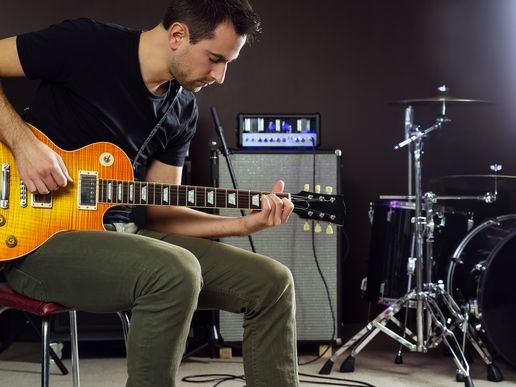We've finally come to the last post in this series. If you missed it, we've been talking about some basic things you can do to help out with guitar bends. Let's do a quick recap of everything we've talked about so far.
- You should be using your thumb as an anchor point for leverage to help distribute the work load when you bend.
- You should also be using your 3rd finger as much as possible for bends, and let your 1st and 2nd fingers help out by pushing the string up with it.
As I mentioned last time, I feel like this final tip is the most important out of the three in our series. Again, with enough experience, you can really use any finger you want for bends, not just your 3rd finger. Also, you don't HAVE to use your thumb if you don't want to.
These are just helpful suggestions, but not at all necessary in making bends.

Be One With The Note
Ok, so go grab your guitar and play that 9th fret on your 2nd string, B again. No bends yet, just play it.
Now, go up one fret higher to 10, and play that note. Listen to the pitch (or sound) that it creates. Let that sound sink in for a few moments. You can play it a few times if you need to, but really let it absorb into your ears.
Now go back to the 9th fret, and try your bend again. Start by picking it, and then slowly push your string up higher and higher until you reach that same pitch that you heard from the 10th fret. This is called a "half step bend", or a "half bend".
We can talk about why it's called that in a different post, but basically, you're changing pitches by a "half step". Deep, I know.
The Real Reason All This Matters
When you're doing bends, it's SUPER important to make sure that you're matching your bend's pitch to the note that you're trying to bend to. The more in-tune your bend is, the more pro you sound.
Now, if you're a beginner guitarist and this is your first real time diving into the world of bends, don't worry too much about it. You're still learning! But, just know that as you keep playing and getting better, your pitch accuracy with bends really should start being paid more attention to.
Try Using A Visual Cue
One thing that helped me when I was learning bends was to use a "visual guide" on my fretboard. This way, I knew if I was hitting the right note.
For example, if I do that same bend on the 9th fret with my electric guitar, I can see that my B string is lining up with the fretboard dot on my 7th fret. What I mean is that as I bend, the string gets closer and closer until finally lining up with the dot on my fretboard. At this point, I can literally see that the bend is now in tune with the right note.
I know, this is a really sloppy way of learning it. Like, really sloppy...
You really (really) should be using your ears to make decisions in an audio-based art. But it actually did help me when I was first starting out, since my ear wasn't quite "tuned up" like it is now. Who knows, maybe this little hack will help you, too?
Another thing you can do if you want to take it a step further, is to use a guitar tuner while practicing bends. You can even use a tuner in addition to the visual cue trick so that you can more easily identify when your bends are in tune. Using a tuner also really helped me improve my ear for bends, too.
Keep Practicing And Stay Encouraged
The most important part of course is to keep practicing!
Not only will you start getting better at doing bends the more you do them, but your ears will naturally start getting better too!
Remember, you're literally creating pitches out of thin air when you bend. When you have nothing to go by other than your memory of a pitch, you're training your ears. That's how they get stronger.
This skill will take some time to develop, so be patient. Don't give up! Think about how you're creating a stronger ear each time you bend.
Hope that helps, and feel free to leave any comments or questions.
To see Part 1 of the series on guitar bends, click here.
To see Part 2, click here.
Great stuff! On the surface bending seems pretty simple but you could probably write a book on that one technique alone. Ill follow you and resteem.
Thanks! And yeah, behind every bend, or any technique really, there are countless hours of practice that go into learning it that most people will never know about.
Thanks for the follow, I followed you back!